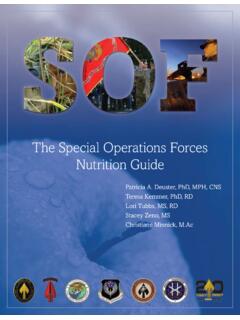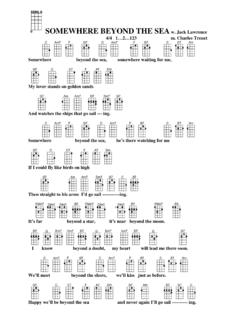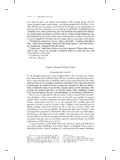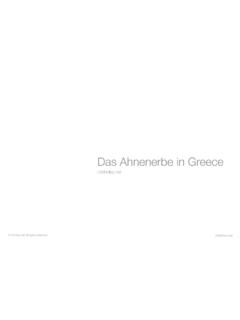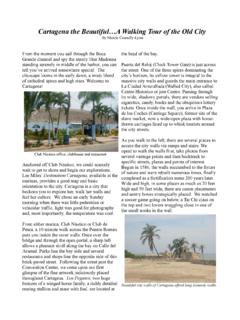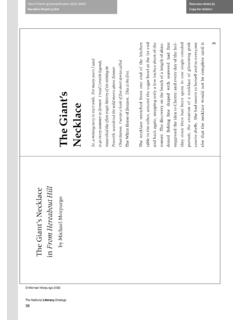Transcription of HELL WEEK! The U.S. Navy's SEA, AIR, LAND (SEAL)
1 HELL WEEK! Welcome to the US navy SEALs. SEALs are the elite Naval Special Operations unit ofthe US navy . The Navy's SEA, AIR, land ( seal ) teams are one of the mostrespected commando forces in the world - they are often cited as the most elite, flexibleand highly trained Naval Commando force. When it comes to Maritime SpecialOperations and Anti / Counter-Terror operations the SEALs are hard to in 1962 by President J. F. Kennedy as a maritime counterpart to the ArmySpecial Forces (the "Green Berets"), the SEALs have amassed a remarkable history ofsuccesses and have become legendary in their exploits. The Teams have operated inevery hellhole known to modern warfare and come away with many victories, somebruises and a vast history of achievements.
2 Most seal missions are unreported andunknown to the general public. Due to focus, dedication and training, the missions havebeen very are trained to operate in small units of one or two men up to platoon strength ofsixteen. However, they work best in squads of eight or fewer. Most missions areclandestine in nature, planned in exacting detail and executed with precision andswiftness. During peacetime, SEALs find themselves with the same rigorous training asduring war. Training remains strict to enforce the belief that the more you sweat inpeacetime, the less you will bleed in Vietnam, seal Teams One and Two amassed a combined kill ratio of 200:1,with only 46 deaths resulting mostly from accidents and poor intelligence, rather thanenemy direct fire.
3 See: foran in-depth look at seal operations in Vietnam and other conflicts. You can learn moreabout seal operations from the numerous books available in the seal Store: short e-book is offered to you free to introduce you to the unique navy seal training program called acronym for Basic Underwater Demolition / seal training. BUD/s is the first or a lifetime of advanced special operations training programsthat prospective SEALs undergo. It lasts for 30 weeks including pre-training if you donot roll-back and is extremely arduous both mentally and physically. If completed which only 20% of those who start do the new SEALs go on to a career in the SEALT eams conducting special operations around the world and supporting the war on terrorat the pointy edge of the unique aspect of navy seal training is HELL WEEK.
4 Originally named MotivationWeek when the training was held at FT Pierce, FL, the week was designed to mentallyand physically test the recruit beyond any normal means in a simulated combatenvironment to determine who would have the True Grit to be a seal . Theresulting sense of accomplishment and awareness of an individual s innate ability toaccomplish significantly more, mentally and physically, than one s previous perceivedlimitations, is a stated outcome of Hell Week. I call this The 20X Factor. Everyone whether a seal recruit, or an assembly line worker at the local GM plant is capable ofaccomplishing at LEAST 20 times what they perceive themselves capable ofaccomplishing. They just need to take some action to unlock this hidden entire e-book from which this is extracted is available at.
5 The book, titled YouWant Us to do WHAT! by Jeff Krause, is an excellent read. Jeff is a rare individualwho has succeeded at navy seal training, Army Ranger training AND US ArmySpecial Forces (Green Beret) training. His experiences, recounted in this book availableonly from , are hilarious and enlightening. Enjoy and thank you verymuch for visiting I hope that your experience was enjoyable,exceeded your expectations and that you will return to join our community as ,Mark DivineUS navy founder, editor and President_____HELL WEEK! Phase I of navy seal Training is eight weeks long. The first three weeks are meant totear down an individual physically. The goal is complete physical fatigue. The fourthweek, affectionately known as Hell Week , is designed to rid the class of any who wereon the verge of quitting by the end of the first three weeks.
6 The final four weeks is anattempt to rebuild the individuals who stayed with the program through the first fourweeks. Training during the final four weeks is designed to make the class physicallystronger and I for Class 123 began on a Monday in January of 1983. It began at 0400, asit did every day, with PT. This first PT consisted of the seal Qualification Test,again! We had taken that same test during boot camp to qualify for SEALs Training, butmore recently we had done it once a week during pre-training. Everyone, with fournotable exceptions, was ready for the four notable exceptions were four students from Kenya, Africa who showedup for that first day of Phase I training. The PT test brought out the fact that two of theKenyans couldn t swim.
7 There was no way those two could continue in BUD/S other two, Njenga and Kabui, managed to pass the swim with considerabledifficulty, and were marginal, but the Commanding Officer of BUD/S decided to let themcontinue through training for as long as and Kabui would not only be with the class at graduation six months later,but they turned into some of the best swimmers in our class. They were not THE best,but they were solidly in the top half. That s pretty impressive considering theirperformance on the first PT Phase I one quickly learns that the instructors are looking for motivation bothon an individual basis and as a class. We learned to sing all kinds of songs! When thegoing really got rough and a student started feeling sorry for himself, or his buddy startedfeeling sorry for himself, he would start singing and the class would join in.
8 We d singsongs as a class to pick up everyone s spirits. This helped motivate everyone to the instructors saw an unmotivated classfeeling sorry for itself they knew how toturn up the pressure to make things twice asbad as they already were. We either startedsinging or things got very very bad in ahurry. We found it to our advantage to actmotivated even when we weren t. Nomatter how bad it got, we learned that things were only half as bad as they could s enough to motivate almost the next six months we would double-time, as a class, everywhere we is a run faster than a trot but not as fast as a sprint. We double-timed to eachmeal, to each evolution, to everywhere we would greet every instructor, as a class, with the traditional, Hoo-yahInstructor So-and-So (whatever his name).
9 Failure to do so, or a mix up in seniority ofinstructors, and the class would get wet. As I mentioned earlier, every BUD/S classwants to stay dry for as long as possible every day. For winter BUD/S classes, such asClass 123, this I particularly words, Sunny Southern California, go so well together that they conjure upvisions of a tropical paradise. Sure, there are palm trees and the climate in San Diego isprobably the best in the continental United States, but that does not mean that the air andwater remain warm all year round. Of course, it never gets as cold as Michigan inJanuary, but the temperature often is in the thirties or low forties at 0400 hours in Januaryand February. The water temperature stabilizes in the low fifties.
10 The constant oceanbreeze, which is heavenly for most of the year, brings on uncontrollable shivers for thecold and wet. Even air temperatures in the fifties could be exceptionally cold when wewere wet and the strong breeze blew right through us. To get wet, was to become cold and wet and shiver for as long as it took ourclothes to dry out. There were only two possible sets of clothes to get wet in. One wasthe navy swimming trunks. The other was the fatigue shirt, fatigue trousers, and combatboots. There was NEVER, a time whenjackets were and wet is a tradition with thewinter classes. It is inevitable. There is noway to avoid it. You WILL be cold and wetduring BUD/S training. I expect that summerclasses have their own nemesis, but for Class123 the cold and wet was responsible for moredropouts than any other single condition.
